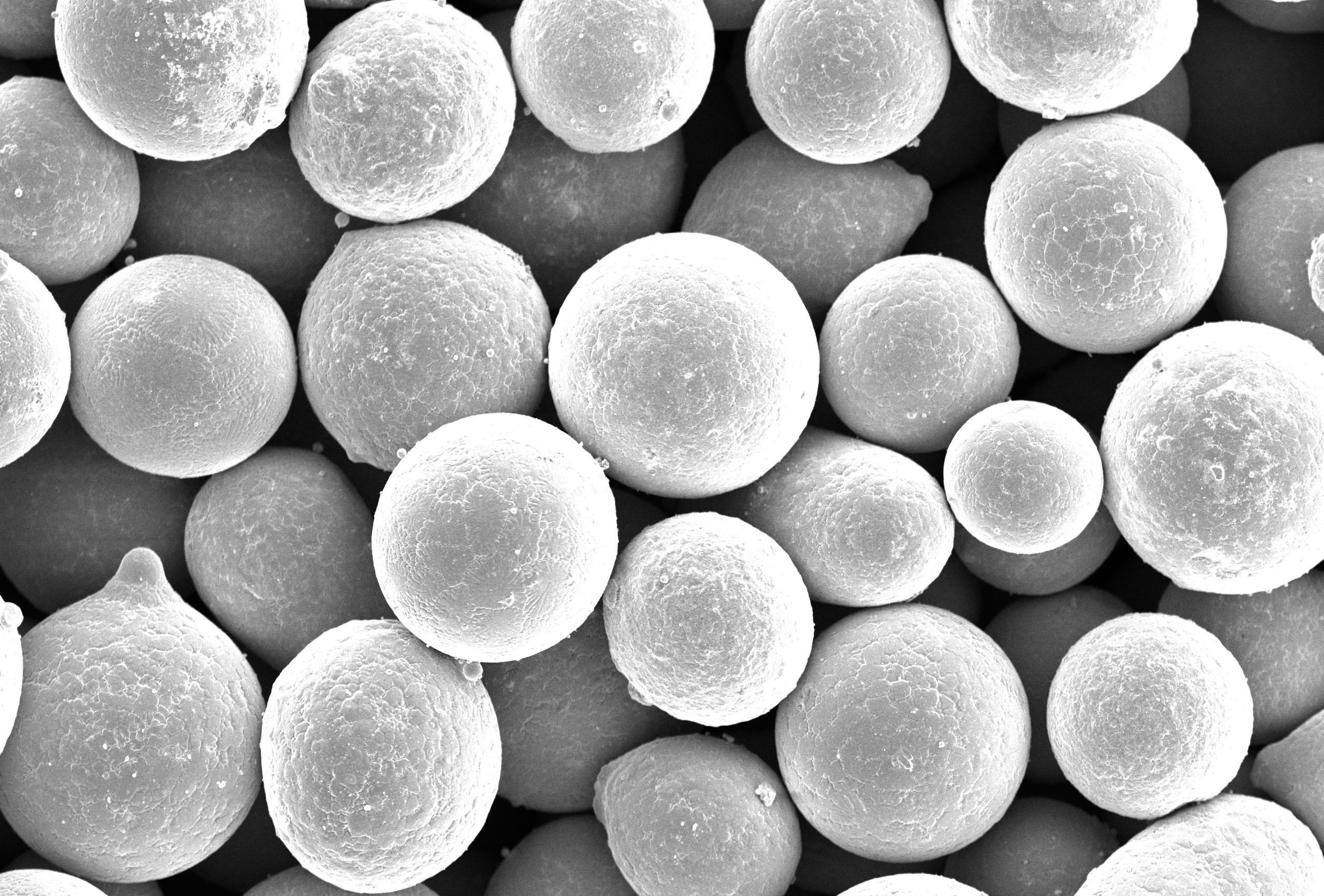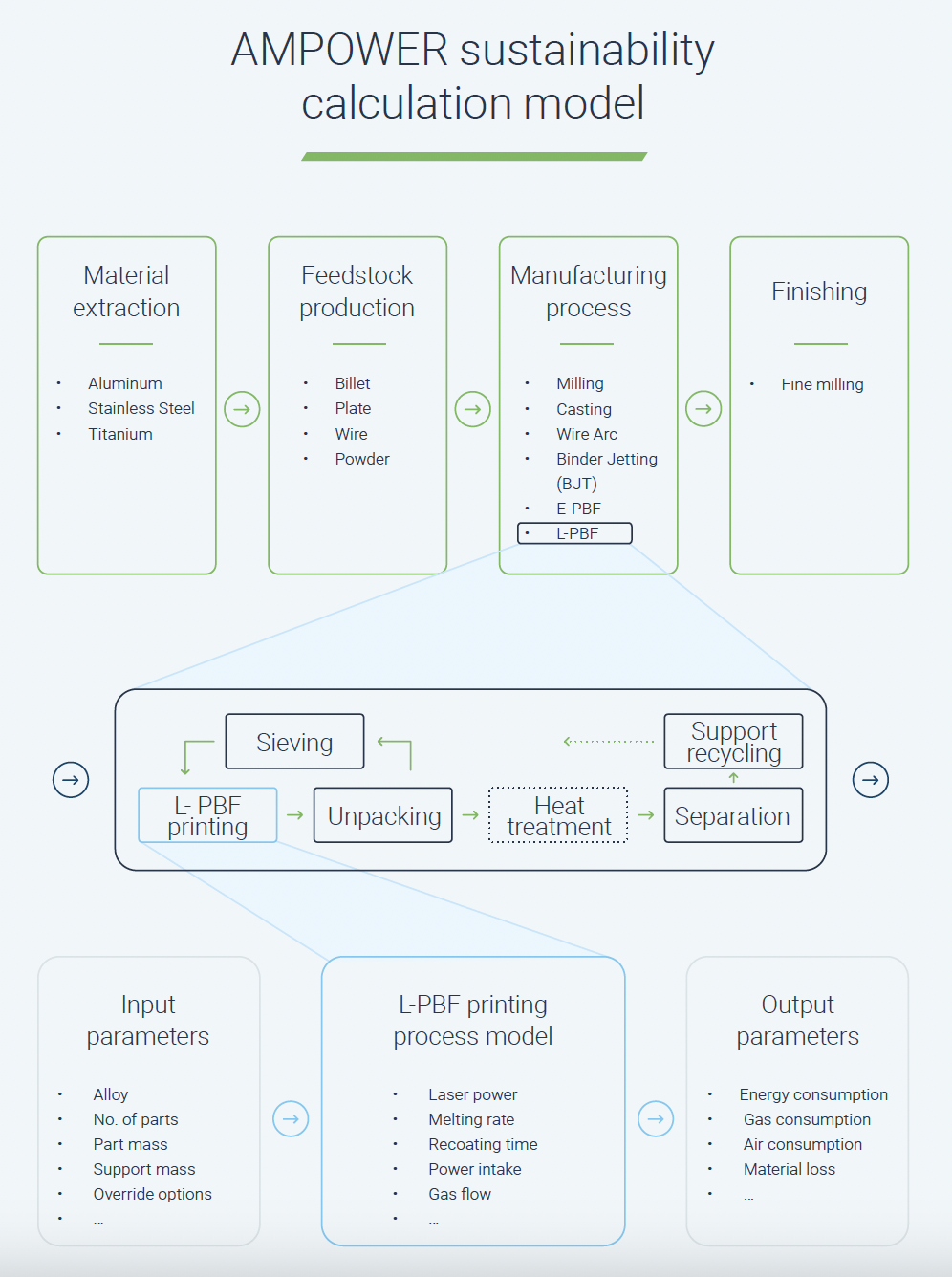Additive manufacturing (AM) has revolutionized the production landscape, enabling unprecedented levels of customization and complex design. However, with its rise, the focus on sustainability within AM has become essential. This article aims to comprehensively explore sustainability in 3D printing, addressing opportunities, challenges, and potential tools for measuring sustainability within the industry.
Opportunities for AM in Sustainability
AM naturally excels at promoting the “triple bottom line” of sustainability, which includes environmental, social, and economic factors. We’ll delve into how AM can be leveraged to optimize these diverse aspects of sustainability.
Environmental Sustainability
- Material Efficiency: One of the critical advantages of AM is its ability to minimize material waste. Unlike traditional manufacturing methods, AM builds objects layer by layer, using only the necessary amount of material. This precision in material placement reduces waste and contributes to cost savings. Companies like BMW have implemented AM to produce lightweight components, saving materials and enhancing fuel efficiency.
- Energy Consumption: Energy efficiency is a cornerstone of sustainability in AM. The technology’s ability to produce intricate geometries with less material contributes to energy savings. In the automotive and aerospace industries, where energy efficiency is a critical driver of innovation, AM enables the production of highly complex parts that enhance overall energy performance. GE Aviation’s LEAP engine, produced using AM, demonstrates a 15% reduction in fuel consumption.
- Recycling and Reuse: Innovations in recycling methods for AM materials can promote a more circular economy. Reusing materials is an integral part of making AM a more sustainable practice. Innovations like HP’s recycling program for 3D printing materials foster a circular economy, encouraging the recycling of polymer materials. Ford collaborated with HP to recycle 3D-printed waste into car parts. Additionally, companies like Continuum, a subsidiary of MolyWorks, are pioneering new recycling technologies that transform scrap metal into feedstock for 3D printing, further enhancing the sustainability of the AM process.
 Marine grade stainless steel alloy. Image courtesy of Continuum.
Marine grade stainless steel alloy. Image courtesy of Continuum.Economic Sustainability
- Cost Efficiency: AM provides opportunities for cost-effective production, especially for small batches or customized products. This includes reduced tooling costs, lower labor expenses, and potential for local manufacturing. A notable example can be found in the production of hearing aids, which enabled customization while offering reduced tooling cost and time-to-market.
- Supply Chain Management: AM has the potential to transform traditional supply chains, offering on-demand production and localized manufacturing. This can lead to reduced shipping costs and decreased overall carbon footprint. EOS has worked with companies like Daimler EvoBus to establish digital and sustainable spare parts management, decentralizing manufacturing to eliminate long transport routes and manufacturing on-demand to avoid overproduction.
- Innovation and Market Growth: Investing in AM technologies fosters innovation and growth in various sectors, enhancing economic sustainability further.
 3D printed spare parts for Mercedes Benz buses produced through OMNIplus. Image courtesy of OMNIplus.
3D printed spare parts for Mercedes Benz buses produced through OMNIplus. Image courtesy of OMNIplus.Social Sustainability
- Accessibility: AM democratizes manufacturing by making it accessible to smaller enterprises and individual innovators. This supports local development and encourages entrepreneurship.
- Education and Workforce Development: The growth of AM requires a skilled workforce. Education and training in AM technologies can foster employment opportunities and support social sustainability. Stratasys is committed to ensuring inclusive and equitable quality education and learning opportunities. By advancing ‘learning by making’ opportunities and leveraging technology to empower students, Stratasys contributes to social sustainability in AM.
- Ethics and Regulation: Ensuring responsible and ethical practices in AM, including intellectual property rights, labor conditions, and safety, is vital for achieving social sustainability.
Challenges of AM in Sustainability
While offering numerous advantages, AM also faces several challenges to becoming a true sustainable manufacturing technique.
- Material Limitations: Around 50% of AM materials are currently non-renewable or challenging to recycle. This creates barriers to circular economy principles and can cause problems in waste management. Developing new materials that are more easily recyclable or biodegradable or finding alternative uses for existing ones may mitigate these challenges.
- Energy Intensity: Some AM processes can be 50-100% more energy-intensive than traditional manufacturing methods. This can contribute to a higher carbon footprint and may be at odds with global efforts to reduce greenhouse gas emissions. Investing in energy-efficient technologies and utilizing renewable energy sources can be critical strategies to align AM with sustainability goals.
- Regulatory Compliance: Ensuring adherence to environmental regulations across different jurisdictions can be complex and costly. Varied and sometimes conflicting requirements can create confusion and hinder innovation. Harmonizing rules, providing clear guidance, and fostering collaboration between governments, industries, and academics may alleviate these challenges. ASTM‘s efforts in regulatory compliance focus on the standardization, qualification, and certification of 3D printing products.
- Lack of Standardized Tools: Tailoring tools for AM sustainability measurement can only be manageable with established guidelines. The absence of standardized methods and tools can lead to inconsistent measurements and evaluations. Collaborative development of standardized tools, guidelines, and best practices can improve alignment and comparability across the industry. The AMPOWER sustainability calculator is a tool developed to calculate energy consumption and CO2 emissions for various alloy and technology combinations in AM, providing a standardized approach to sustainability measurement.
- Technology Accessibility: Although AM offers localized manufacturing opportunities, the initial investment and expertise required can be barriers for small and medium enterprises (SMEs). Making education, training, and financing more accessible can support the broader adoption of AM, fostering innovation and economic sustainability.
By recognizing and addressing these challenges, the industry can move toward more responsible and sustainable practices in 3D printing. The collaborative efforts of all stakeholders will be crucial in realizing a more sustainable future for AM.
Measuring Sustainability in 3D Printing
Navigating AM’s sustainability requires precise measuring tools, and here’s why:
- Holistic Assessment: These tools comprehensively examine environmental, economic, and social impacts.
- Iterative Refinement: They support continuous sustainability improvements, setting benchmarks, and guiding strategies.
- Data-Driven Decisions: Informed choices, from materials to operations, stem from accurate metrics.
- Regulatory Alignment: Beyond ensuring compliance, these tools aid transparent stakeholder communication.
- Enhancing Reputation: Commitment to transparency boosts trust and positions firms favorably in the market.
- Global Goals Synergy: Tools align AM practices with larger frameworks like the UN’s SDGs.
- Innovation Catalyst: They drive the exploration of new materials/processes, offering competitive differentiation.
Sustainability measurement tools are not just an operational necessity but a strategic imperative to address challenges and unlock its full range of opportunities. These tools guide organizations in making informed decisions, fostering innovation, ensuring compliance, building trust, and contributing to broader societal goals using AM.
Now, let’s look at some notable tools and how they can be applied:
1. Life Cycle Assessment (LCA)
- LCA is used to analyze the environmental impacts of a product throughout its life cycle, including material sourcing, manufacturing, usage, and end-of-life disposal.
- Method: It involves data collection on energy and material inputs, emissions, waste generation, etc. Then, the data is mapped into environmental impact categories like climate change, ozone depletion, and water consumption.
- Tools: Software like SimaPro and OpenLCA offers specialized modules for AM, enabling a detailed analysis of the specific processes.
- Example: A Life Cycle Analysis (LCA) study conducted with YOU MAWO and Fraunhofer EMI found that 3D printed eyewear by EOS is 58% more sustainable in carbon footprint and creates 80% less waste than conventional manufacturing.
- Challenges & Solutions: Ensuring accurate data collection can be challenging, so standardizing methodologies and utilizing industry-specific databases can increase reliability.

Source: “Comparative LCA of a Low-Pressure Turbine (LPT) Bracket by Two Manufacturing Methods,” by AMGTA
2. Material Flow Analysis (MFA)
- MFA quantitatively tracks materials through the AM process to identify areas of inefficiency and waste.
- Method: It involves tracking the flow of specific materials through various stages of production, identifying losses and inefficiencies, and analyzing them in context to suggest improvements.
- Tools: Software like STAN provides visualization and modeling capabilities tailored to AM.
- Example: Gautam Kulkarni discusses the design and evaluation of a front brake caliper prototype for Formula Student cars in the study titled “Design and Analysis of Fixed Brake Caliper using Additive Manufacturing”(2023). The research likely utilized Material Flow Analysis to understand the flow of materials and the manufacturing process involved in creating the brake caliper using AM.
- Challenges & Solutions: Balancing detail with feasibility is crucial, so modular approaches focusing on critical materials or stages can streamline the process.
3. Sustainable Value Stream Mapping (SVSM)
- SVSM is a visualization tool that maps material and information flow through manufacturing, highlighting sustainability metrics.
- Method: Traditional Value Stream Mapping is expanded to include environmental and social indicators, providing a more holistic view of sustainability in AM.
- Tools: Workshops and training in lean manufacturing principles can help incorporate SVSM in AM operations.
- Example: A study titled “Productivity Improvement Using Simulated Value Stream Mapping: A Case Study of the Truck Manufacturing Industry”(2022) by Fikile Poswa et al. discusses the application of SVSM in the truck manufacturing industry. The research utilized simulated value stream mapping to identify non-value-adding times in critical workstations and proposed solutions to eliminate them, resulting in a productivity improvement of 4%. This study showcases the practical application of SVSM in manufacturing to enhance productivity and efficiency.
- Challenges & Solutions: Integrating sustainability metrics requires expertise, so collaboration with sustainability professionals can enhance the process.
4. Eco-Efficiency Indicators
- These indicators provide a ratio of the economic value generated to the environmental impact, offering a concise measure of sustainability.
- Method: By quantifying economic performance and environmental effects, these indicators allow for a balanced evaluation of AM’s sustainability.
- Tools: Guidelines from organizations like WBCSD offer industry-specific applications.
- Example: A study titled “Biochar filler in MEX and VPP additive manufacturing: characterization and reinforcement effects in polylactic acid and standard grade resin matrices”(2023) by N. Vidakis et al. investigated the efficiency of using eco-friendly biochar as reinforcement in AM. The study likely utilized Eco-Efficiency Indicators to evaluate the environmental and economic aspects of using biochar in AM processes.
- Challenges & Solutions: Selecting appropriate metrics requires alignment with broader sustainability goals, so consistent communication with stakeholders can guide the process.
5. Social Life Cycle Assessment (SLCA)
- Beyond environmental considerations, SLCA analyzes the social impacts of a product’s life cycle.
- Method: It assesses factors like labor rights, community engagement, and social development, adding a human dimension to sustainability in AM.
- Tools: The UNEP/SETAC Guidelines offer a framework for implementing SLCA in various industrial contexts, including AM.
- Example: A study titled “Additive manufacturing of recycled plastics: a ‘techno-eco-efficiency’ assessment”(2023) by H. Jayawardane et al. explored the social impacts of 3D printing and recycled feedstock material. The study utilized SLCA to assess the social implications of using recycled PLA in AM.
- Challenges & Solutions: Social metrics can be subjective, so applying established frameworks and engaging with stakeholders can ensure relevance and accuracy.
6. AM Power’s Sustainability Measurement Tool
- Allows the calculation of energy consumption and CO2 emissions for various alloy and technology combinations in AM, considering the complete process chain.
- Method: Incorporates a detailed process model, considering all process steps and material recycling. It calculates energy consumption and converts it into CO2 emissions.
- Tools: AMPOWER Sustainability Calculator
- Challenges & Solutions: It requires a tailored approach considering various factors.
 Source: AMPOWER
Source: AMPOWER
Conclusion
AM stands at the forefront of technological innovation, offering unparalleled opportunities for customization, efficiency, and sustainability. While the path to fully sustainable AM presents challenges, the concerted efforts of industry leaders, governments, researchers, and innovators are paving the way. A notable example is the Additive Manufacturing Global Trade Association (AMGTA), a non-profit organization that promotes the environmental benefits of AM and commissions research to foster sustainable practices.
Integrating sustainability into AM is not merely a trend but a necessity in our rapidly evolving world. The AM community can move toward more responsible and sustainable practices by recognizing and addressing challenges, embracing opportunities, and utilizing comprehensive measurement tools. Collaboration and innovation will be vital in realizing a more sustainable future for AM, where economic prosperity, environmental stewardship, and social responsibility are harmoniously intertwined.
Subscribe to Our Email Newsletter
Stay up-to-date on all the latest news from the 3D printing industry and receive information and offers from third party vendors.
Print Services
Upload your 3D Models and get them printed quickly and efficiently.
You May Also Like
Consolidation in AM: How 2025 Is Shaping the Industry’s New Normal
The first half of 2025 has been marked by a clear shift in the additive manufacturing (AM) industry. Companies are no longer just focused on developing new tech by themselves....
Etsy Design Rule Change Reduces Selection of 3D Printed Goods
Online marketplace Etsy has implemented a rule change requiring all 3D printed goods on the site to be original designs. The update to the site’s Creativity Standards states, ¨Items produced using...
U.S. Congress Calls Out 3D Printing in Proposal for Commercial Reserve Manufacturing Network
Last week, the U.S. House of Representatives’ Appropriations Committee moved the FY 2026 defense bill forward to the House floor. Included in the legislation is a $131 million proposal for...
Transforming From Tourist to Native: Duro CEO Michael Corr Explains Why the Company Rebuilt its PLM Software on AI
In these early innings of the AI boom, many market analysts have expressed concern that AI spend has gotten too far ahead of the technology’s proven ability to deliver significant...

































